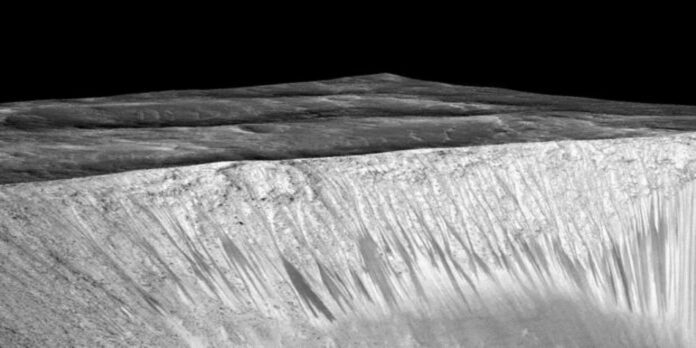
The cause of the dark streaks on some slopes of Mars, known as “recurring sloping lines” (RSL), is a subject of heated debate among space scientists: some believe that ephemeral and superficial flows of water salty are responsible, while others consider landslides to be a more likely explanation. Now, a group of researchers from the SETI Institute is betting on the second option but activated by a chemistry of the Martian subsoil that occurs in a similar way on Earth. For years, scientists analyzing the surface of the red planet have detected clusters of dark, narrow lines that appear seasonally on steep slopes facing the sun and in warmer regions. Previous research suggested that these enigmatic dark streaks are signs that saltwater flows regularly on the red planet during its warmer seasons.
THE BRINE HYPOTHESIS DISPROVED
Recent missions to Mars have revealed that the planet has huge underground ice pockets. Previous work suggested that warmer temperatures during the Martian spring and summer could help generate salty brines capable, at least for a time, of staying liquid in the cold air of the red planet. However, geologists have discovered problems with the hypothesis of the brines that cause these streaks,” explains Janice Bishop, a planetary scientist at the SETI Institute and NASA’s Ames Research Center, and lead author of the study, which was just completed. publish in “Science Advances.” For example, the angle of the slopes where these lines appear and the features surrounding their origins “are largely inconsistent with a liquid flow process,” Bishop told Space.com.
That is, its structure would not correspond to a flow of water falling down a hillside. The theory of Bishop and his colleagues is that subsurface chemical reactions could make the Martian surface vulnerable to landslides, causing these stripes. “Although the surface of Mars today is dry, rough and cold and dominated by wind and abrasion, microscale interactions of salts with small particles of ice and liquid water can still occur below the surface,” says Bishop.
THE IMPORTANCE OF TABLE SALT ON MARS
The scientists focused on the chemical reactions between sulfate minerals such as gypsum with chloride salts. “On Earth, interactions between gypsum and chloride salts – table salt is a variety – have caused parts of some caves to collapse, sink in soft sediments near lakes and salty ponds, and lift roads,” Bishop said. Could a similar phenomenon be occurring on Mars? The researchers say yes, although different conditions in our neighborhood would slow down these reactions. To test their theory, the researchers conducted laboratory experiments with mixtures of sulfates, chloride salts, small ice particles, and volcanic ash similar to Martian soil.
Such mixtures were frozen and thawed at the low temperatures recorded on the red planet. The researchers found thin films of muddy water that formed on the surfaces of the mineral grains and suggest that these films could expand and contract over time, causing disruptions and contractions below the Martian surface. Wind and dust could trigger landslides, producing the lines seen in photographs. The team notes, however, that upcoming missions to the Martian surface will be key to testing this model. And who knows what more mysteries of our neighbor.








